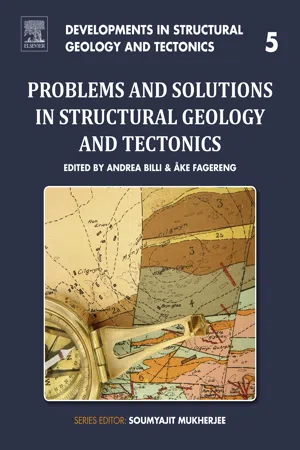
- 316 pages
- English
- ePUB (mobile friendly)
- Available on iOS & Android
About this book
Problems and Solutions in Structural Geology and Tectonics, Volume 5, in the series Developments in Structural Geology and Tectonics, presents students, researchers and practitioners with an all-new set of problems and solutions that structural geologists and tectonics researchers commonly face. Topics covered include ductile deformation (such as strain analyses), brittle deformation (such as rock fracturing), brittle-ductile deformation, collisional and shortening tectonics, thrust-related exercises, rift and extensional tectonics, strike slip tectonics, and cross-section balancing exercises. The book provides a how-to guide for students of structural geology and geologists working in the oil, gas and mining industries.- Provides practical solutions to industry-related issues, such as well bore stability- Allows for self-study and includes background information and explanation of research and industry jargon- Includes full color diagrams to explain 3D issues
Frequently asked questions
- Essential is ideal for learners and professionals who enjoy exploring a wide range of subjects. Access the Essential Library with 800,000+ trusted titles and best-sellers across business, personal growth, and the humanities. Includes unlimited reading time and Standard Read Aloud voice.
- Complete: Perfect for advanced learners and researchers needing full, unrestricted access. Unlock 1.4M+ books across hundreds of subjects, including academic and specialized titles. The Complete Plan also includes advanced features like Premium Read Aloud and Research Assistant.
Please note we cannot support devices running on iOS 13 and Android 7 or earlier. Learn more about using the app.
Information
Cross-Section Construction and Balancing: Examples From the Spanish Pyrenees
Abstract
Keywords
1 Introduction
- (1) It honors the available data and is consistent with known geological concepts (admissible cross-section).
- (2) It is retro-deformable. This means it can be recomposed into a plausible predeformational geometry (restored cross-section).
- (3) There is no gain or loss of material between the deformed and the restored states (balanced cross-section). This means that if we compare the deformed and the predeformational restored strata geometries, there are no large gaps or overlaps. For this assumption to be correct, cross-sections must be parallel to the tectonic transport direction.
Table of contents
- Cover image
- Title page
- Table of Contents
- Copyright
- Contributors
- About the Series
- Preface
- Part I: Integrating Observation and Interpretation To Understand Tectonics, Past and Present
- Part II: Relating Observed Deformation To Stress And/Or Strain History
- Part III: Observations and Interpretations In Fieldwork and Hand Specimens
- Part IV: Adding Modern Methods To Field Geology
- Part V: Geophysical and Structural Techniques In Petroleum Geoscience and Borehole Projects
- Part VI: Novel Integration of Mathematical Methods, Computer Science, and Structural Geology
- Author Index
- Subject Index